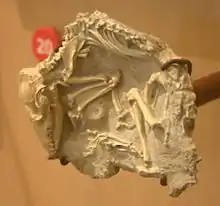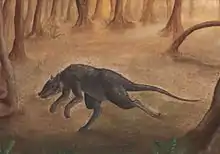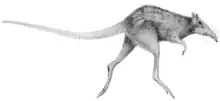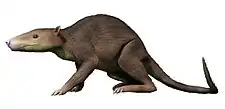| Leptictis Temporal range: Late Eocene to Early Oligocene, | |
|---|---|
 | |
| Leptictis cf. acutidens | |
 | |
| Restoration of a Leptictis | |
| Scientific classification | |
| Domain: | Eukaryota |
| Kingdom: | Animalia |
| Phylum: | Chordata |
| Class: | Mammalia |
| Order: | †Leptictida |
| Family: | †Leptictidae |
| Subfamily: | †Leptictinae |
| Genus: | †Leptictis Leidy, 1868 |
| Type species | |
| †Lepticitis haydeni Leidy, 1868 | |
| Species | |
| |
Leptictis is an extinct genus of leptictid non-placental eutherian mammal known from the Late Eocene to Early Oligocene of North America.[1] The type species, L. haydeni, was named in 1868 by Joseph Leidy in honour of Ferdinand Vandeveer Hayden. L. dakotensis was also named by Leidy in 1868, but he originally named it as a separate genus, Ictops, which is now seen as the same animal as Lepticitis. Since then, six other species have been named.[2][3] The hind limbs are proportionally elongated compared to their forelimbs similar to elephant shrews, though to a lesser degree than Leptictidium, and it is suggested that they were capable of rapid bursts of quadrupedal locomotion, unlike the bipedal locomotion suggested for Leptictidium. The forelimbs were likely used for digging.[4]
References
- ↑ E. D. Cope. 1873. Third Notice Of Extinct Vertebrata From The Tertiary of the Plains. Paleontological Bulletin 16:1-8
- ↑ McKenna, Malcolm C., and Bell, Susan K. 1997. Classification of Mammals Above the Species Level. Columbia University Press, New York, 631 pp. ISBN 0-231-11013-8
- ↑ Kenneth, D. R. (2006). The postcranial skeleton of early Oligocene Leptictis (Mammalia: Leptictida), with a preliminary comparison to Leptictidium from the middle Eocene of Messel. Palaeontographica Abteilung A, 278(1-6), 37–56.
- ↑ Ruf, Irina; Volpato, Virginie; Rose, Kenneth D.; Billet, Guillaume; de Muizon, Christian; Lehmann, Thomas (2016-01-20). "Digital reconstruction of the inner ear of Leptictidium auderiense (Leptictida, Mammalia) and North American leptictids reveals new insight into leptictidan locomotor agility". Paläontologische Zeitschrift. 90 (1): 153–171. doi:10.1007/s12542-015-0276-2. ISSN 0031-0220. S2CID 56166050.


